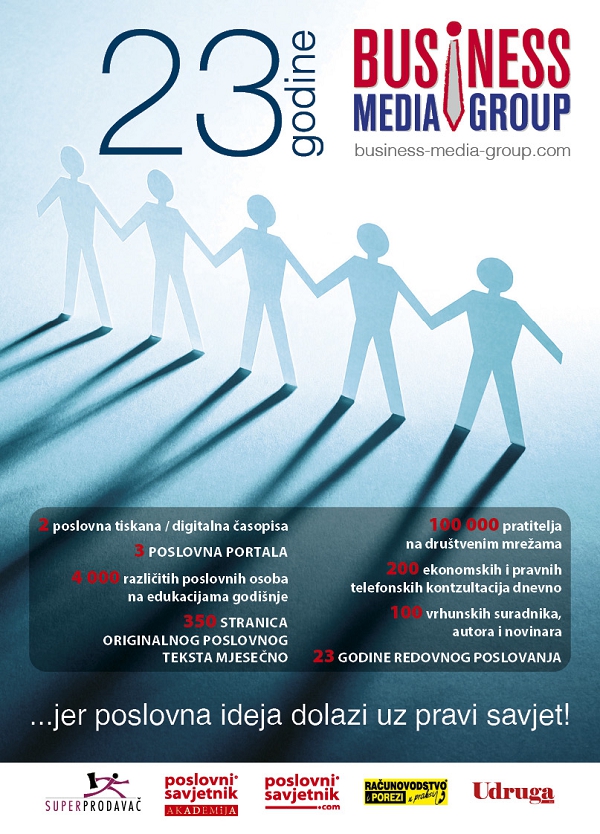JOHNN LODDER: Competitiveness and disruptive markets - Innovation is about cooperation and trust!
Croatia ranks 77 out of 140 countries in the Global Competitiveness Report 2015-2016 (GCI), there is no significance change since 2008. This is a very sad result because Croatia has so much potential which still is not exploited.
The GCI report is an annual assessment of the 136 factors that drive productivity and prosperity. The GCI report finds a close link between competitiveness and an economy’s ability to nurture, attract, leverage and support talent. The top-ranking countries all do well in this regard. But in many countries, too few people have access to high-quality education and training, and labour markets are not flexible enough. The Report names the most problematic factors for doing business in Croatia:
- inefficient bureaucracy
- instable politics
- complexity of tax rates
- restrictive labour regulations
- an inadequate workforce
- corruption
- a poor work ethic in the labour force.
The failure to embrace long-term structural reforms that boost productivity and free up entrepreneurial talent is harming the economy’s ability to improve living standards, to solve persistently high unemployment and to generate adequate resilience for future economic downturns. (source: http://reports.weforum.org/global-competitiveness-report-2015-2016/)
Leveraging the human factor
At the heart of an economy’s competitiveness is its capacity to leverage talent.
High unemployment figures weigh heavily on societies, risking not only prolonged lower demand and customer investments, but also the de-skilling of a significant segment of the labour force and growing discontent.
This is even stronger in the post-crisis years, which coincide with a fundamental shift away from the traditional manufacturing industry while the widespread use of ICT is generating entirely new industries and disrupting others. Talent-driven economies are best equipped to adapt to the changes brought about by this tech revolution and to reap their benefits.

A tool for all stakeholders
Growth recovery in unchartered territory will require recognizing the need for a shared assessment and an understanding of the future sources of competitiveness. This Report serves to inform and support policy-makers, businesses and civil society in their development of a shared, long-term vision.
Competitiveness is a complex and often protracted process that demands difficult trade-offs, careful consideration for sequencing reforms and room for calibration in changing conditions. Steering the course towards enhanced competitiveness requires vigilance and commitment from all stakeholders and throughout the process. Without all stakeholders fully involved you will not make any progress.
Innovation and disruption
Disruptive Innovation is top 1 subject on the agenda of 80% of global CEO’s and top managers.
In many economies we see that good quality, top customer service and sustainability are no strategic issues anymore, they became commodities. Companies cannot differentiate on these items anymore because customers expect this from every supplier. If it is not delivered customers simply change to your competitor.
All this makes innovation the number 1 priority for every company, also looking at the consequences of ‘the Fourth Industrial Revolution’. (See my previous columns in Poslovni Savjetnik).
The complexity and speed of disruptive innovation today means that only the multinationals are (still) able to invest enough in innovation.
Smaller companies cannot effort this anymore; they have no option then to cooperate with other companies, governmental institutions and universities to be able to reach a high level of innovation.
Risk-management is another high priority of CEO’s.
- Internal questions are for instance: How to profit fast from new, disruptive technologies? How to create opportunities while keeping up a good image and reputation? And how do you get your organisation, your people going along with you? Controlled progress and improvement is what the CEO likes, but, if this is possible in the fast changing disruptive reality is the question. So, making the organisation flexible is another hot item in 70% of the boardrooms.
- But externally there are also relevant questions like: How to cooperate with other companies on innovation projects? How do we know that we can trust them?
A management dilemma is that we need to cooperate with others but we cannot risk to loose our investments to cheating partners.
These are just a few actual items that are regularly on the agenda of an average company and average board room. (source: Berenschot Strategy Trends 2016)
What is disruptive innovation?
Disruptive innovation means ‘the process of developing new products or services to replace existing technologies and gain a competitive advantage.’
Practically: a disruptive product or service addresses a market that previously couldn’t be served (a new-market disruption) or it offers a simpler, cheaper or more convenient alternative to an existing product (a low-end disruption.)
In practice we see that many markets already are shaken up by new parties who offer surprising new products and services, or have innovative business models, or have aggressive marketing strategies.
Think of well-known names like Tesla, Uber, Airbnb, SnappCarr, Nextdoor, Waze, Spotify, Picnic, HelloFresh, Zalando, Booking.com, Virgin and Amazon.
These are all young companies who became successful because they disrupted their sector.
Van Leeuwen mentions six main factors that may cause disruption in your market or sector:
1. Overcapacity
Much overcapacity or waste in a sector offers opportunities for innovative entrepreneurs who can do the same more efficient, cheaper and more customers friendly. The circular economy is based on this principle.Cars stand still most of the time, Lorries often drive without cargo, parking’s and cellars are often empty. What a waste, so let’s share and (re-)use it with intelligent logistic solutions.
Through SnappCar, Peerby en PakUp we share cars, tools and parking places. Walmart (USA) uses their customers to deliver shopping goods to other customers. BlaBlaCar (a French carpool service start-up) wants its users to also send parcels.
The bigger the inefficiency in a sector is, the bigger the opportunity for disruptive solutions.
2. Transparency
A sector that is not transparent about the quality of their services, the trustworthy of the providers or the price-quality relation are actually asking for new parties that will provide clarity.Bookings.com and Airbnb are very successful because you see exactly what you get:, if the price is fair and how other customers value the quality and reliability of the current offer in the market.
Transparency is good for customer trust so companies that offer it will have a higher brand preference and brand loyalty. Many sectors do not have that transparency like notary’s, doctors, dentists, and bank- and insurance companies.
3. Inconvenience
If customers have to do big efforts to get what they need than new companies who will perform better win the game. Most of the time customers have to adjust to the working process of the provider instead of the other way around. Think of a hospital, a doctor, or the garage for your car.Carglass understood this and comes to your home or workplace to repair your broken windscreen.
Making it easy for the customer is also the big driver behind new formulas like Picnic (online supermarket). Or the success of taxi service Uber who offers you as a customer much more service for less money than the not customer oriented taxi services. Cities where Uber is active showed a decrease of 35-45% of taxi prices
4. Under one roof
In many sectors the offer for customers is often too extensive or customers are condemned to a one-stop-shop. Think of the complete packages and subscriptions you have to buy for television, internet, a mobile phone or financial services. Customers often want to have less, but….So consumers choose for ‘call simple’ and ‘sim only’ subscriptions. The all under one roof formula is popular in many sectors like hospitals for a diagnosis, treatment, staying, recovery, medication etc. This offers opportunities for companies who specifically focus on a single service like Breyer or Scanadu.
5. ‘Under the radar’
Be careful when someone enters your sector with a product that seems simpler or has a worse quality than your product. It could be the disruptive innovation that will turn your market upside-down.The essence of such a product is that at first it ‘flies under the radar’ because it is a new, small player in the market; but in time it will slowly improve and become interesting for your target group or even the mass market. Often it will then be too late to stop this newcomer because their price-quality relation is not doable for you.
Think of a 3D-printed prosthesis like a 3D-robothand for 50 euro, but that is not as good as your 6000 euro high-tech hand prosthesis. Developments in 3D-printing go fast, so, the question is how soon this development will become a serious threat to traditional prosthesis makers.
6. Unneccesary
New technological developments can in no time create a decrease of need for your product or service. Like newspapers that are replaced by news portals, postmen who have less work because of e-mails or the disappearance of physical products as records, cd’s, photo’s, books and video’s because of digitalisation.This meant the end of companies like Kodak, Polaroid and Polare. But opportunities for newcomers like Apple with iTunes, and iPhone, Spotify, Netflix and Amazon. TomTom was only a few years successfully in the market and got overtaken by navigation apps on the mobile phone.
Difficulties also came for electronica shops, travel bureaus and insurance sellers. Look at the success of newcomers like Coolblue, internet insurances and on-line travel shops.

This trend of ‘dis-intermediation’ also gives possibilities for new business because customers do not see ‘the trees in the wood’ anymore. Sites that compare products, quality and prices became a big success like cheapflights.com etc.
The question is how your sector is organised and structured. And, how big is the chance that at any moment soon there is no need for your product or service anymore. Will there be a need for driving schools and private drivers when the ‘self-driving’ car is already on the market? Tesla is nearly there!
Disruption will strike in all sectors
It is expected that every sector, sooner or later, will be confronted with disruption. Just think about the banking sector. Banks take care of 85% of all on-line payments.
But this is not as normal as it seems. In China it is exactly the other way around; 85% of the on-line banking payments are done by non-banking companies like Alibaba and Samsung.
In Europe Apple, Google and all kinds of fin.tech.start-ups are eager to attack the monopoly of the traditional banks.
Another sector where many disruptive innovations are expected is the Health Care sector. Companies like Apple (development tools), IBM (Watson), Philips (Salesforce), GE-Medtronic (pacemakers and pumps) and Johnson & Johnson (pharmacy) already launched platforms for medical applications.
On the consumer side we see, next to Apple, also Microsoft, Google, Amazon, Intel and Samsung coming with platforms where the accent is on the storage of healthcare data generated from smartphones, wearables and sensors in a secured cloud.
Other care platforms aim on elderly and chronical illnesses like the Dutch Quli and VieDome, the Belgium Cubigo and the Finnish Active Life Village; for self-management and care at distance through image care, apps and domotica.
The health care sector will change drastically through all kinds of different platforms. Within 5 years there will be at least 7 new job positions that we do not know yet. It has consequences for hospitals, care-organisations, doctors, medical specialists and patients.
The disruption-wave is still to come
Trend watchers, management gurus, consultants and techno-adepts expect that the big wave of disruptive innovations and business models by ‘exponential growing companies’ with ‘exponential technologies’ will come soon.
So you are warned because it is as researchers Doz en Kosonen stated: “Companies are often victims of their own success. They do not die because what they did was wrong, but because they kept doing it for too long.”
Innovation in Croatia
Croatia ranks at place 92nd on innovation and scores only a very low 3.1 (7 is max) in the Global Competitiveness Report. This is based on 7 factors but the main cause is that there is no cooperation between all stakeholders. Other reasons are mentioned in the introduction of this column.
However, from my experience in leading workshops, trainings and management coaching, I think the most important and basic reason is the absence of trust.
As a generalisation: ‘CEO’s and managers do not trust their employees, employees do not trust their managers and CEO’s’. Of course there are exceptions and these are the companies that perform best, but I guess the 80/20 rule is, unfortunately, very applicable.
On internet 95% of all information about any company is available for everyone; ask your business intelligence/marketing manager about it. The slogan ‘Knowledge is power’ died in the 1960’s, now it is about networking and exchanging information to do business. And doing business is based on Trust.
One example
The Intelligent Community Forum, a non-profit think tank, named Eindhoven's tech neighbourhood (Brainport) as the world's smartest region in 2011. The one-square-kilometer area is home to more than 100 companies and institutes and some 8,000 researchers, developers, and entrepreneurs who churn out nearly 50% of all Dutch patent applications. (source: http://fortune.com/2012/09/19/7-best-new-global-cities-for-startups/)
In 2015 Eindhoven (Netherlands) was called the ‘Silicon Valley of Europe’ with an open collaboration between big companies (like Philips, DAF-trucks etc), smaller companies and businesses, start-ups and the Technical University of Eindhoven (TUE). They work together in projects aimed on innovation and based on the exchange of information and ideas, and yes, especially based on mutual trust.
Trust
These companies invest money and contribute with their research, know-how and skills; the Technical University contributes with their scientific expertise, research possibilities and skills.
Their vision is to find global solutions for questions in sectors as a.o. health care, energy, ict and mobility. National and local governments support these projects with investments, knowledge and simplified administrative procedures.
After 5 years the result so far is a track record like:
- 120 spin-off companies
- 40 new student companies
- 60 TU Eindhoven patents
- 60 patent licenses
- 500 patents of third parties
Everything that is successful is ‘copied’, so now there are similar innovation centres in the Netherlands in Nijmegen, Delft, Rotterdam and Amsterdam.
The Netherlands now rank 8th on innovation in this last Global Competitiveness Report.
They understood the necessity for sharing valuable information and learned how to cooperate with other stakeholders and how to trust them.
Potential of Croatia
Croatia has the potential to do much better than it does now.
All stakeholders should be involved and they should put aside personal pride and status, political dogmas, possible controversies and start talking about the only relevant question:
‘What is the most important action we can think of to bring Croatia up to place 15 in the GCI ranking?’
Government, Businesses and Universities should start with open dialogues to create a shared vision for 2030 and discuss the ‘How to make it happen?’ and ‘What can I contribute?’
This might sound as unrealistic; however, there are so many success stories of regions and countries that did it! They succeeded against all odds, all beliefs and all expectations. Why not in Croatia?
As Walt Disney once said: ‘If you can dream it, you can do it’.
In my next column I will write about a successful innovation project in which 6 big international competitors worked effectively together.
John Lodder MA., MSc.
www.balance-consultancy.com















